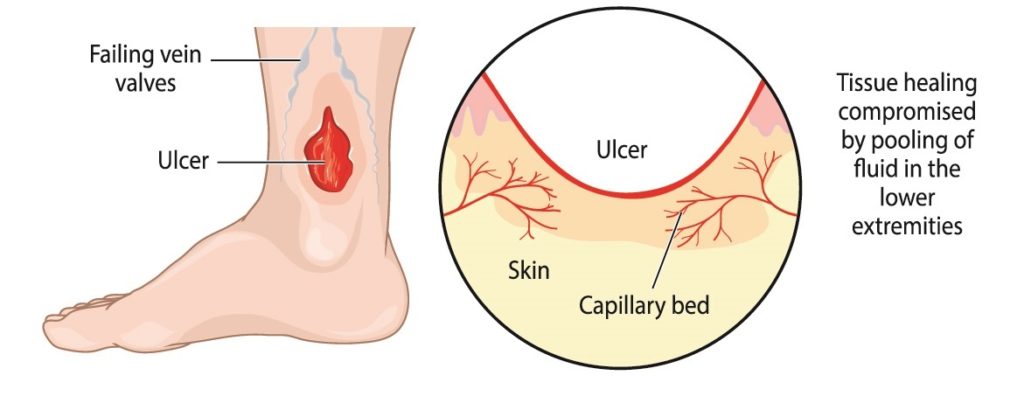Have you noticed a persistent wound on your leg that just won’t heal? It could be a venous ulcer, a common condition that affects millions of people worldwide. While venous ulcers aren’t life-threatening, they can be painful, affect your quality of life, and even increase your risk of infection.
What is a Venous Ulcer?
Venous ulcers are open sores that develop on the lower leg, usually around the ankle. They occur due to poor circulation caused by damaged veins. Normally, veins have one-way valves that help blood flow back to the heart. When these valves weaken or become damaged, blood can pool in the legs, leading to increased pressure and eventually tissue breakdown.
Risk Factors for Venous Ulcers:
- Age: As we age, our veins lose elasticity, increasing the risk of developing venous ulcers.
- Varicose veins: These twisted, enlarged veins are a sign of weak valves and can contribute to venous ulcers.
- Obesity: Excess weight puts extra strain on the veins in the legs.
- Sedentary lifestyle: Sitting or standing for long periods can lead to blood pooling in the legs.
- Blood clots: A history of deep vein thrombosis (DVT) can damage veins and increase the risk of ulcers.
- Family history: Having a family member with venous ulcers makes you more susceptible.
Signs and Symptoms of Venous Ulcers:
- A persistent open wound, usually on the lower leg near the ankle
- Surrounding skin that’s red, discolored, or inflamed
- Pain or tenderness in the affected area
- Swelling in the leg
- Itching or burning sensation
Living With Venous Ulcers:
If you suspect you have a venous ulcer, it’s crucial to see a doctor for proper diagnosis and treatment. Early intervention can help prevent complications and promote healing. Here are some ways to manage venous ulcers:
- Compression stockings: These specially designed stockings help improve circulation and reduce swelling.
- Wound care: Keeping the ulcer clean and protected is essential for healing. Your doctor will provide specific instructions on wound care techniques.
- Elevation: Elevating your legs above your heart can help reduce swelling and promote blood flow.
- Lifestyle changes: Maintaining a healthy weight, exercising regularly, and avoiding prolonged sitting or standing can all help manage venous ulcers.
- Medication: In some cases, medications may be prescribed to improve circulation or reduce inflammation.
Living a Full Life Despite Venous Ulcers:
With proper treatment and lifestyle changes, many people with venous ulcers can live active and fulfilling lives. If you’re concerned about a leg wound, don’t hesitate to seek medical attention. Early diagnosis and management are key to preventing complications and promoting healing.
Disclaimer: This blog post is for informational purposes only and should not be taken as medical advice. Always consult with a healthcare professional about your individual situation.
With proper treatment and lifestyle changes, many people with venous ulcers can live active and fulfilling lives. If you’re concerned about a leg wound, don’t hesitate to seek medical attention. Early diagnosis and management are key to preventing complications and promoting healing.
Disclaimer: This blog post is for informational purposes only and should not be taken as medical advice. Always consult with a healthcare professional about your individual situation.


